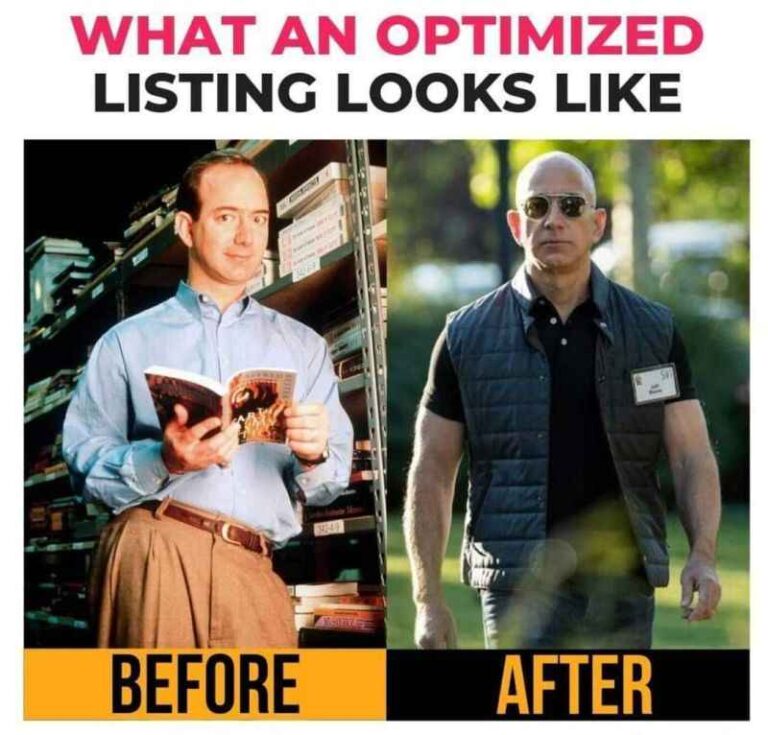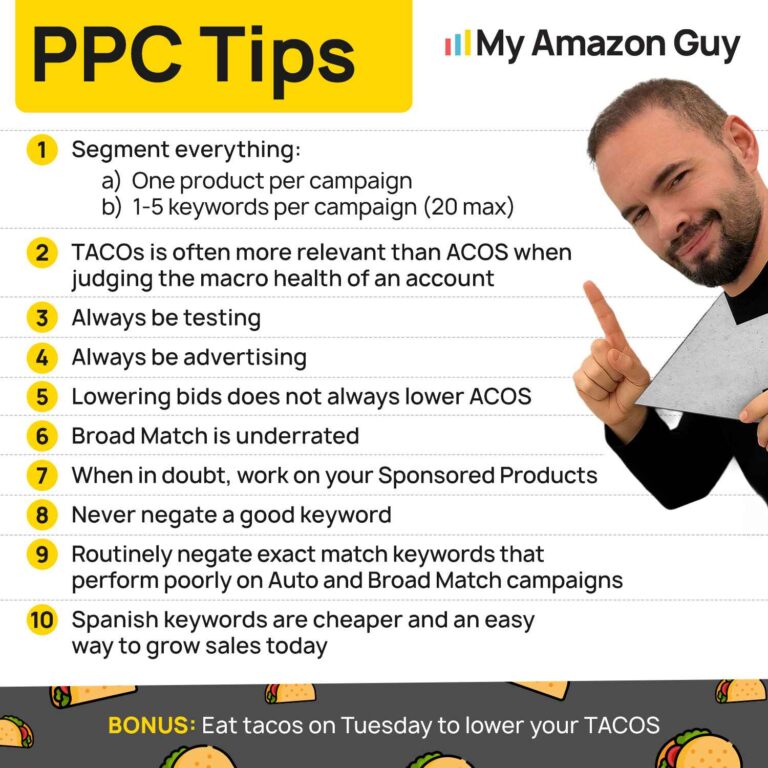You can learn Amazon selling from LinkedIn posts for free, but only if you know which posts are worth your time.
63,500+ followers don’t lie. Neither do 4,115 posts of pure value.
Steven Pope has built something rare on LinkedIn: a following based entirely on expertise. What separates Pope from the crowd isn’t just his follower count; it’s what those followers do with his insights.
When he shares a strategy for optimizing listings, sellers implement it. When he breaks down Buy Box factors, conversion rates improve. When he reveals his approach to PPC management, ad performance climbs.
LinkedIn has evolved beyond networking into a masterclass platform where genuine experts share battle-tested strategies. Pope represents the best of this evolution: an operator who’s built his reputation not through sales pitches, but through content so valuable that competitors study it and sellers screenshot it.
TL;DR
As founder of a leading Amazon agency, Pope could easily keep his best strategies behind client paywalls. Instead, he shares them freely. His posts go viral because they solve real seller pain points with specific, actionable advice instead of generic fluff.
Here are his top 10 posts and the key lessons you can learn from each.
Table of Contents
End Seller Headaches
Stop battling complex Amazon issues and let our expert team handle them for you.
1. Fixing Seller Support (600 Likes)
Pope’s 5-step plan to overhaul Amazon’s support system struck a nerve because it addressed the single biggest frustration in the Amazon ecosystem. Sellers constantly battle generic responses, escalations that lead nowhere, and support agents who don’t understand basic FBA concepts.
This post was effective because it didn’t just complain about the problem; it offered a concrete solution with specific changes to alleviate seller frustration. The massive engagement proved sellers are desperate for someone to articulate their support nightmares and propose real fixes.
Why it resonated
Every Amazon seller has horror stories about Seller Central support tickets that go nowhere fast.
Key takeaway
When you identify a universal pain point and offer specific solutions, your content will naturally gain traction.
Here is one of the most notable comments on Steven’s post.
Georgi Zayakov"I am fed up with the generic copy-paste answers of Seller Support, which don't solve my problems."
2. Optimized Listing Meme (562 Likes)
Steven Pope’s meme became popular because it used a simple, humorous, and powerful visual analogy to explain a complex business concept. It cleverly equates the transformation of an Amazon listing from weak and ineffective (“before”) to powerful and dominant (“after”) with Jeff Bezos’s well-known physical transformation, making the benefit of optimization instantly understandable.
Why it resonated
It perfectly captured the desired transformation of a product listing from overlooked to a market force using a familiar and funny subject.
Key takeaway
Using a strong, simple analogy is a highly effective way to make a dry business topic memorable and shareable.
One of the standout comments on Steven’s post.
Nojus Latvinskas"The guy is jacked up on the right picture from lifting boxes in the warehouse probably."
3. New Seller Top 3 Tips (556 Likes)
This meme post from Steven Pope became incredibly popular because it uses a well-known, humorous format to articulate a deep-seated frustration within the Amazon seller community.
It perfectly visualizes the hierarchy of support: “Amazon” (the parent) dotes on “Big Brands,” ignores the struggling “Small Businesses,” and has completely forgotten about “New Sellers,” who are humorously depicted as a skeleton at the bottom of the pool.
It’s a dark but highly relatable joke for anyone who has felt invisible or unsupported by the platform.
Why it resonated
It validates the feeling among small and new sellers that they are playing a different, much harder game than the major brands on the platform.
Key takeaway
Content that uses humor to highlight a shared struggle creates a powerful sense of community and is extremely shareable.
A particularly insightful comment from Steven’s post is:
Arva Akbar"A well depicted click that literally explaining the condition of Amazon Sellers. Ofcourse Newcomers have to face a lot of challenges but if they'll come with full research and proper techniques things will be more likely easy to face than that of all who are not coming with full optimization and research."
4. The Lambo Lesson (541 Likes)
This post about the “Lambo Lesson” became popular because it tells a compelling and counterintuitive story about the psychology of business perception.
Instead of just showing off a luxury car, Steven Pope frames it as a surprising business experiment. The anecdote at the UPS store where a familiar face suddenly sees him as a guru worth paying, all because of the car, serves as a perfect, real-world case study on how visible signals of success can dramatically change how potential customers perceive you.
Why it resonated
It reframed a luxury purchase not as an expense, but as a surprisingly effective marketing tool that creates instant authority and attracts business.
Key takeaway
Perception matters immensely in business, and powerful, visible signals of success can create opportunities that expertise alone might not.
This comment on Steven’s post really stood out.
Daniil Lobko"What people here don't see is how many years of hard work go into making a toy like this run. Respect Steven Pope."
5. Buy Box Cheat Sheet (532 Likes)
Pope’s breakdown of Buy Box determinants provided clarity on a topic shrouded in speculation and misinformation. Sellers constantly lose sales to competitors without understanding why they’re not winning the Buy Box, making this tactical content incredibly valuable.
The post succeeded because it demystified a complex algorithm using plain language and prioritized factors by importance. Sellers got actionable insights they could implement immediately to improve their Buy Box win rate.
Why it resonated
The Buy Box algorithm remains one of Amazon’s most mysterious and critical ranking factors.
Key takeaway
Content that explains Amazon’s “black box” algorithms will always attract engaged audiences hungry for insider knowledge.
Check out this notable comment from Steven’s post.
Rich DePencier"This is really helpful Steven Pope! Always grateful for the experience and for the learning you share with us all. This topic on better understanding of the factors that influence the Buy Box on Amazon is critical."
Consider this a masterclass in e-commerce marketing, where the path to an Amazon seller’s heart is paved with equal parts data, dopamine, and disaster.
Outsmart Your Competition
Don't lose the Buy Box again. Let us build a strategy to help you dominate your niche.
6. CTR Magic for SEO (519 Likes)
This post about CTR became popular because it created a powerful “aha!” moment for many sellers. While most are focused on traditional keyword optimization, this post revealed a different, often-overlooked lever for SEO success.
By simplifying the algorithm’s “thinking” with clever analogies like CTR being a signal to Amazon that a product is the “favorite kid” it made a complex concept feel intuitive and gave sellers a new, powerful way to think about getting more visibility.
Why it resonated
It revealed the hidden but crucial connection between customer clicks and search ranking, giving sellers a new competitive advantage.
Key takeaway
The most valuable content doesn’t just give tips, but explains the underlying ‘why’ to create a genuine breakthrough in your audience’s understanding.
Among the many comments, here’s one of the most memorable on Steven’s post.
Muhammad Adeel"Agree. Maximizing CTR on Amazon is key! Elevate relevance, capture interest, and optimize keywords for higher visibility and sales."
7. Keyword Pyramid Method (486 Likes)
This post about the “Journey of a Keyword” became popular because it directly addresses one of the most overwhelming aspects of Amazon selling, keyword management for SEO and PPC, and provides a clear, structured solution.
Instead of offering a random list of tips, Steven Pope presents a comprehensive framework that visually maps out the entire process from initial research to long-term optimization. The Egyptian-themed infographic is the key; it’s a brilliant tool that makes a complex, multi-stage strategy feel manageable, linear, and easy to follow.
Why it resonated
It transformed the chaotic and overwhelming process of keyword management into a clear, step-by-step visual framework that sellers could actually follow.
Key takeaway
Providing a structured framework or a visual roadmap for a complex process is far more valuable to an audience than just offering a list of disconnected tips.
Here’s a standout comment on Pope’s LinkedIn post.
Saad Wali"Amazing insights, I have launched a product in July, and results are amazing Steven Pope . Thanks for the platform, knowledge and wisdom."
8. Family Legacy Brands (447 Likes)
Pope’s plan to give each child a profitable brand at 18 reframed Amazon selling as long-term wealth building rather than short-term hustle. This perspective elevated the entire industry by positioning FBA businesses as legitimate assets worthy of inheritance planning.
The engagement came from the aspirational vision, sellers saw Amazon success as a pathway to family legacy rather than just personal income. Pope’s long-term thinking inspired sellers to build more sustainable, valuable businesses.
Why it resonated
The concept of building generational wealth through Amazon brands inspired sellers thinking beyond quick profits.
Key takeaway
Providing a structured framework or a visual roadmap for a complex process is far more valuable to an audience than just offering a list of disconnected tips.
Steven Pope"There's still time for me to even the boys and girls out. Maybe it will be 4-4 after I have another three kids?"
9. Hiring 50 Amazon Interns (440 Likes)
Pope’s intern program post addressed the talent shortage plaguing Amazon agencies while creating opportunities for newcomers to enter the industry. This initiative showed genuine commitment to community building beyond just business growth.
The post succeeded because it demonstrated thought leadership through action. Instead of just talking about industry problems, Pope created a solution that benefits everyone; experienced sellers get trained help while newcomers get career opportunities.
Why it resonated
The Amazon community values leaders who invest in developing the next generation of professionals.
Key takeaway
Posts showcasing community investment and industry development generate respect and engagement from peers.
This is a significant comment from Steven’s post.
Larosh Afridi"Great opportunity! Best company to kick start your career."
10. Why I Sold My Brand (408 Likes)
Pope’s transparent account of losing $250K on a struggling FBA brand provided rare insight into the less glamorous side of Amazon selling. His willingness to share specific numbers and mistakes resonated with sellers who’d experienced similar setbacks.
The post worked because it normalized failure as part of the entrepreneurial journey while extracting actionable lessons from the experience. Sellers appreciated the honesty and learned from Pope’s mistakes without paying the same tuition.
Why it resonated
Failure stories often teach more valuable lessons than success stories, especially when shared with brutal honesty.
Key takeaway
Authentic failure stories that include specific lessons learned create deeper connections than polished success stories.
One of the top comments from Steven’s post, right here.
Timothy Reed"Proud of you Steven! Always love your content. Appreciate you guys looking at my stuff as well."
What Makes Steven Pope's Posts Work
Pope’s most successful LinkedIn content shares three common elements that Amazon sellers consistently engage with:
Practical specificity over generic advice. Each post provides concrete steps, exact numbers, or detailed frameworks rather than vague suggestions.
Pain point solutions. Every high-performing post addresses a real problem that Amazon sellers face daily, from Buy Box mysteries to support frustrations.
Contrarian insights backed by experience. Pope challenges conventional wisdom with perspectives earned through managing real Amazon businesses, not just theory.
Best Practices for Learning on LinkedIn
Look for Actionable Takeaways
Don’t just scroll. Read posts with the goal of finding a concrete tip or strategy you can apply to your own work. The most valuable posts offer practical advice, not just high-level concepts.
Engage in the Comments
The comments section is where a lot of the real learning happens. Read through them to see how others are interpreting the information and to find additional insights. Ask questions or share your own perspective to build a more meaningful connection.
Save and Reference
When you find a post with a great tip or strategy, save it. This creates a personal library of resources you can easily reference later when you’re ready to put the advice into action.
Learn Amazon Selling From LinkedIn Posts FAQs
1. How do I find other Amazon experts on LinkedIn?
Look for experts who share detailed, actionable posts. Verify their track record (agency, podcast, etc.) and check for high-quality discussions in their comments section.
Or simply check out My Amazon Guy's other team members like Noah Wickham, Francisco Valadez, and Kevin Sanderson.
2. How do I avoid bad or outdated advice?
Always cross-reference tips with Amazon's official guidelines. Avoid anyone promising "guaranteed results" and follow multiple experts to identify best practices.
3. What's the best way to organize what I learn?
Use a note-taking app to save and categorize posts by topic (PPC, SEO, etc.). Focus on implementing one new takeaway each week to turn knowledge into action.
4. Is it better to read posts or engage with them?
Engaging is much better. Asking thoughtful questions can get you direct answers from experts and helps you build your professional network.
5. What are the limitations of learning from LinkedIn?
LinkedIn is great for strategy and high-level ideas. For highly technical or case-specific problems, use in-depth resources like Amazon's Seller University.
Ready to Apply These Insights?
The best LinkedIn posts for Amazon sellers combine tactical value with authentic storytelling. Whether you’re sharing optimization frameworks or business lessons learned the hard way, focus on providing specific solutions to common seller problems.
Which of Pope’s insights will you implement in your own Amazon business first? The strategies that generated the most engagement often deliver the biggest results when applied consistently.
Turn Insights into Action
Knowing what to do is the first step. Let our team handle the implementation to get you results faster.






